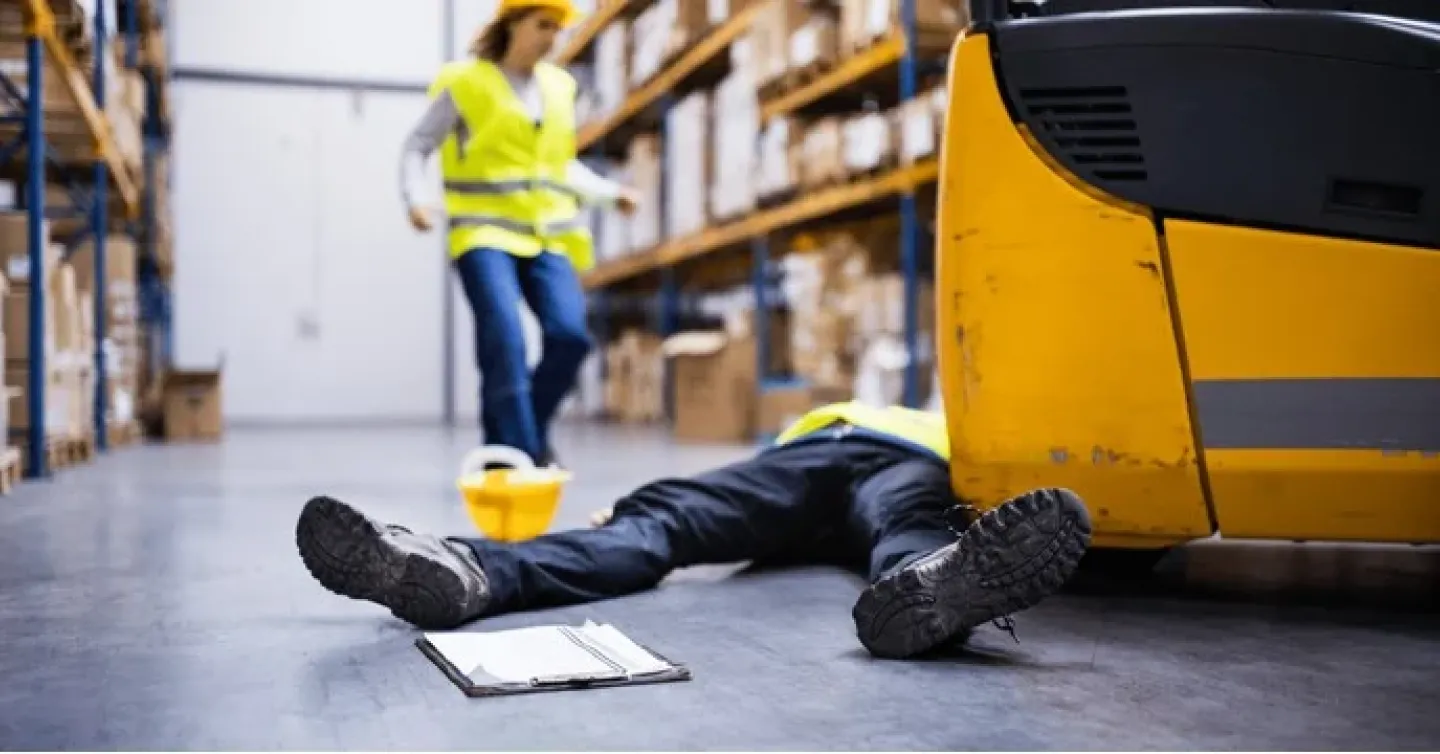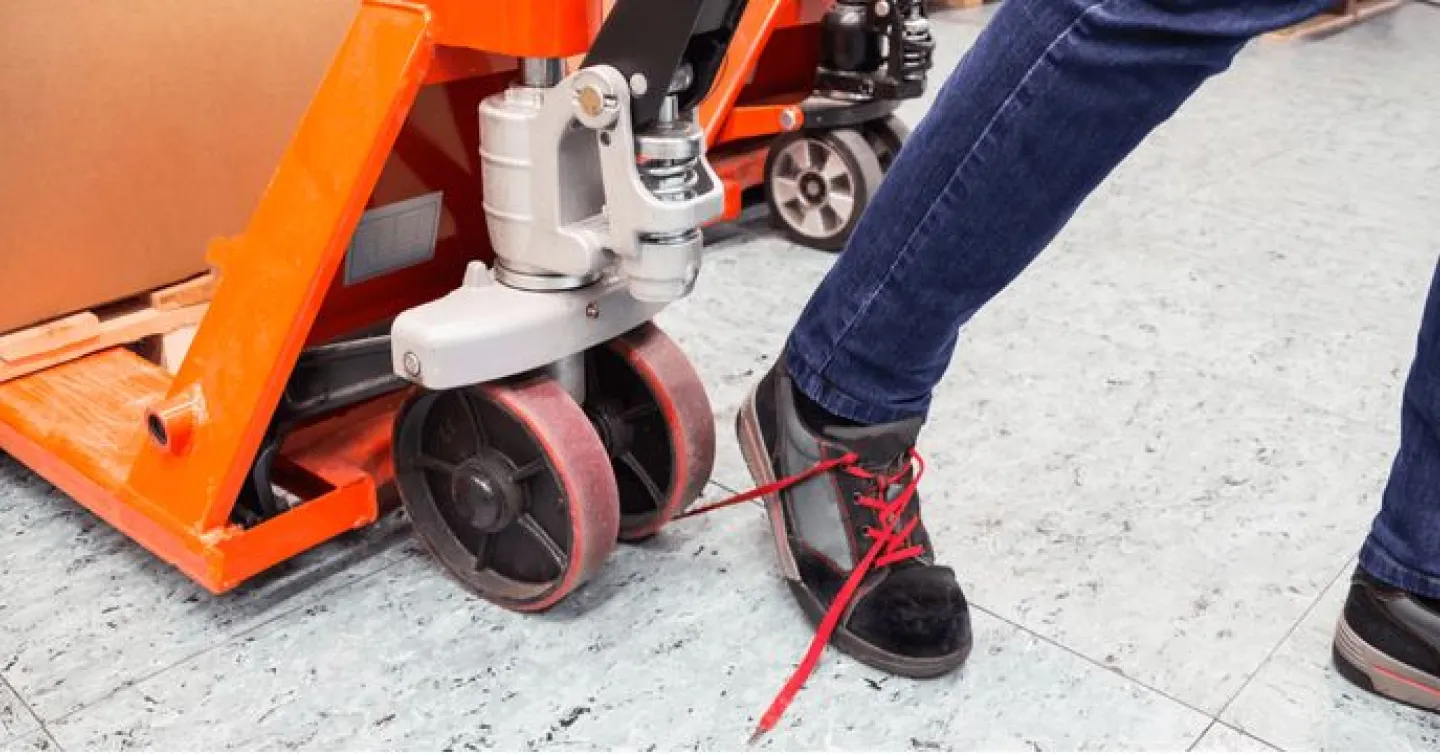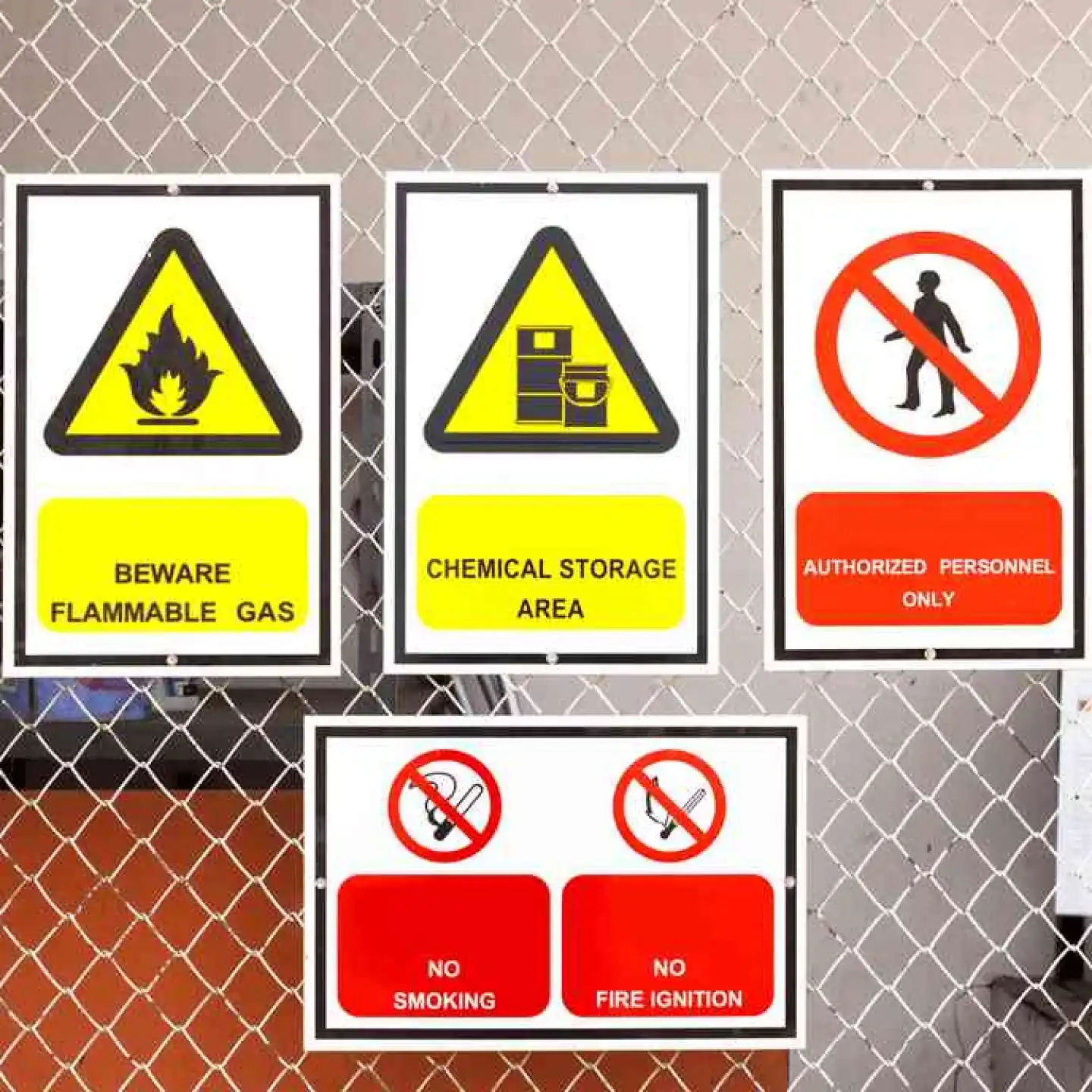Warehouse safety is a top concern for both managers and frontline staff—especially given the high stakes involved. According to recent data, there were 5,283 fatal work injuries in the U.S. in 2023, reflecting a rate of 3.5 fatalities per 100,000 full-time workers. Notably, the transportation and warehousing sector ranked among the highest-risk industries. Therefore, prioritizing warehouse safety across all warehouse operations is not just beneficial—it can significantly reduce these numbers and protect lives.
In this article, we’ll cover:
- The most common workplace injuries in warehouses
- Practical safety tips to prevent them
- First-aid advice for handling injuries on-site

Common Workplace Injuries
The first step toward improving warehouse safety is understanding the most common types of injuries—and what causes them. By identifying these risks early, warehouse operators can take proactive steps to create safer, more efficient warehouse operations.
Heavy Equipment Accidents
Forklifts, pallet jacks, and other heavy warehouse equipment are essential to warehouse operations; however, they also pose major safety risks. For example, workers may be struck by forklifts, crushed between trailers and lifts, or fall from elevated platforms. In many cases, these accidents occur in crowded aisles, especially when forklift safety protocols are ignored or when operators have not received adequate training.
To reduce these risks, warehouses must implement and enforce proper training, equipment maintenance routines, and clear safety procedures.
Slips, Trips, and Falls
Slips, trips, and falls account for a large portion of warehouse-related injuries. Common causes include slick or uneven flooring, poorly placed cords, and buildup of debris, grease, or packaging materials in walkways.
Maintaining clean, clutter-free floors and addressing surface issues promptly is critical to prevent these avoidable injuries.
Exposure to Chemicals
Many warehouses store or use chemicals that can be harmful to employees. As a result, accidental spills or leaks—even when unpredictable—can lead to burns, respiratory issues, or other serious health problems. To address these risks effectively, proper handling and response procedures must be in place. In particular, clear labeling, adequate ventilation, proper storage, and well-defined spill response protocols are all essential for minimizing chemical hazards.
Falling Objects
Stacked inventory, if not properly secured, can fall from shelving and injure nearby workers. These incidents are often the result of improper racking, rushed storage, or overloading shelves beyond capacity.
Regular safety audits, load testing, and well-trained staff help reduce the chances of falling-object injuries.
Machine Entanglement
Among the most serious warehouse injuries is machine entanglement—when clothing, limbs, or hair become caught in moving equipment. In many cases, this happens when safety guards are missing or when workers are unaware of the machine’s designated operational zones. To prevent these life-threatening incidents, it is essential to implement strict lockout/tagout procedures, ensure the use of protective equipment, and provide continuous safety training.

Recent Trends in Warehouse Safety
According to the Bureau of Labor Statistics (BLS), in 2023, there were 28 fatalities in the warehousing and storage industry, and the total recordable case rate was 4.7 per 100 full-time workers. Clearly, while safety protocols have improved over time, the warehousing sector still faces significant risks. Furthermore, a report by the National Safety Council (NSC) found that over 50% of all workplace injuries in warehouses are related to overexertion, improper lifting techniques, and repetitive stress—highlighting the critical need to prevent musculoskeletal disorders.
Although these statistics suggest a slight downward trend in fatalities, the importance of continuing to prioritize safety cannot be overstated. In fact, OSHA reports that proper safety measures can reduce workplace injuries by up to 40%. This finding strongly reinforces the necessity of conducting regular inspections, providing ongoing training, and ensuring effective implementation of safety protocols.
10 Warehouse Safety Tips
Creating a safe work environment doesn’t stop at drafting a safety plan—it requires consistent execution. To reduce injuries and maintain a culture of workplace safety, warehouses must conduct regular training, inspections, and evaluations. Below are ten actionable tips to reduce potential hazards and promote safer warehouse operations:
1. Eliminate Potential Hazards Promptly
A common hazard in a warehouse environment is poor housekeeping. Slippery floors, scattered debris, exposed cords, or cracked surfaces can all lead to slips, trips, and falls. To minimize risk, conduct regular floor inspections and keep pathways clear to protect both employees and equipment.
2. Eliminate Potential Safety Hazards
It is important to ensure floors are free of slip and trip hazards. It is also vital that the staff understands the importance of good housekeeping. Regular checks should be performed on any stray cords, liquids, accumulated debris, cracks, and pits on the floor. These can cause severe injuries to employees and damage valuable machinery and cargo.
3. Clearly Mark Hazard Zones
Use signs, floor markings, and safety stickers to alert workers of hazardous areas—especially around loading docks, heavy machinery, or chemical storage zones. Emergency exits and evacuation routes should be highly visible and unobstructed at all times.

4. Provide Ongoing Safety Training
Proper safety training reduces the high risk of injury in warehouse environments. Regular training sessions ensure that all employees understand emergency procedures, safe equipment use, and how to respond to workplace accidents—especially around machinery and hazardous materials.
5. Enforce Appropriate Clothing Standards
Employees should avoid loose-fitting clothes that can get caught in machines or shelving. Wearing personal protective equipment (PPE)—including gloves, hard hats, high-visibility vests, eyewear, and masks—is crucial for reducing injury risk, especially in high-traffic or hazardous zones.
6. Promote Situational Awareness
To further strengthen workplace safety, encourage a safety-first mindset among all team members. Throughout daily operations, workers should remain alert to potential hazards, such as moving forklifts, shifting inventory, or blocked pathways. Furthermore, maintaining open communication and promoting a culture of awareness can help prevent accidents before they occur, ultimately fostering a more responsive and vigilant workforce.
7. Practice Shelving Safety
Overloaded or unstable racking systems can collapse or cause falling objects to strike workers. Always follow weight limits and stack goods properly to ensure rack stability. Warehouses should conduct regular checks to confirm that shelving remains safe and compliant with OSHA standards.
8. Prioritize Vehicle Safety
Operating powered industrial trucks, forklifts, and lift trucks requires strict adherence to safety rules. Enforce speed limits, encourage cautious turning, and train workers to minimize reversing and stay aware of blind spots. Establish a zero-tolerance policy for reckless or distracted driving.
9. Run Fire Safety Drills
To maintain a consistently safe environment, warehouses should routinely test fire alarms, smoke detectors, and emergency lighting. Additionally, regular fire drills help ensure that every team member is familiar with the evacuation plan and can exit quickly and safely during emergencies. Beyond basic fire preparedness, it’s also wise to install alarms that detect gas or chemical leaks, as these elements pose significant and often overlooked hazards in many warehouse environments.
10. Ensure Proper Ventilation
Poor air circulation can trap dust, fumes, or carbon monoxide from forklifts. This reduces comfort and increases health risks. Use exhaust fans, carbon monoxide detectors, and HVAC systems to control temperature, reduce contaminants, and support air quality throughout the facility.
“In 2023, the warehousing industry reported 28 fatalities and a total recordable case rate of 4.7 per 100 full-time workers”
Understanding OSHA Standards for Warehouse Safety
Warehouses are required to comply with OSHA standards, which ensure a safe work environment for all employees. OSHA’s regulations cover various aspects of warehouse operations, from equipment usage and chemical handling to employee training and emergency response. These standards are not just guidelines—they are legally enforceable, and failure to adhere to them can result in severe penalties.
Some key OSHA regulations for warehouses include the following:
- Forklift and powered industrial truck safety: OSHA requires that all forklift operators be trained and certified to operate these vehicles safely. In particular, they must be familiar with hazards such as loading docks, narrow aisles, and blind spots to minimize crush injuries and prevent accidents.
- Personal protective equipment (PPE): Additionally, OSHA mandates that employers provide appropriate PPE, such as hard hats, gloves, and safety goggles—especially when employees are working with chemicals, heavy equipment, or in areas with potential hazards.
- Chemical safety: Furthermore, OSHA’s Hazard Communication Standard (HCS) requires warehouses to clearly label hazardous chemicals and ensure that employees are properly trained in handling and responding to chemical spills or leaks.
- Fire safety: Finally, fire alarms, sprinklers, and extinguishers must comply with OSHA standards to ensure worker safety during emergencies. In addition, fire drills should be conducted regularly to familiarize employees with emergency exits and evacuation procedures.
Non-compliance with OSHA standards can lead to fines and increased liability for workplace injuries, making it crucial for warehouse operators to stay informed about and comply with the latest OSHA regulations. Regular safety audits and employee training are key to maintaining compliance.
Proper First Aid in Case of an Emergency
While warehouse safety tips can significantly reduce the likelihood of injury, the reality is that workplace safety is never fully guaranteed. In the event of an emergency, performing the correct first aid is crucial for minimizing harm and potentially saving a life. Because of this, first aid training should be mandatory for all employees to ensure they can respond effectively when it matters most.
First Aid Kit Requirements
The Occupational Safety and Health Administration (OSHA) requires the following items to be included in a basic first-aid kit:
- Adhesive bandage and tape
- Medical gloves
- Antibiotic application
- Roller bandages (2 and 4 inches)
- Antiseptic
- Scissors
- Burn dressing
- Splint
- Cold pack
- Sterile/trauma pads
- Eye/skin wash
- Tourniquet
- First aid guide
- Triangular bandage
- Hand sanitizer
Basic First-Aid Procedures
Even with strong safety protocols in place, accidents can still happen in a warehouse environment. That’s why it’s essential for employees to be equipped with the knowledge and confidence to act quickly during emergencies.
To support this, the following basic first-aid procedures—as recommended by the American Heart Association and the American Red Cross—can help workers respond effectively to some of the most common warehouse-related injuries. When applied correctly, these steps can reduce the severity of injuries and, in some cases, save lives.
Cardiac Arrest:
- Call 911 immediately.
- Start chest compressions—press hard and fast in the center of the chest while allowing for recoil between compressions.
- If trained, provide rescue breathing alongside chest compressions.
- Use an Automated External Defibrillator (AED) as soon as possible.

Crush Injuries:
- Call 911 immediately.
- Apply direct pressure to stop the bleeding.
- Cover the injury with a wet cloth and elevate it above the heart level.
- If the injury affects the head, neck, or spine, immobilize the area to prevent further damage.
Fractures:
- Call 911 immediately.
- Do not attempt to straighten the limb.
- Stabilize the area with a splint and padding.
- Apply a cold pack to reduce swelling (avoid placing ice directly on the skin).
- Elevate the extremity to reduce swelling and pain.
- Provide anti-inflammatory drugs (e.g., ibuprofen) to help manage pain.

Bleeding:
- For deep wounds, call 911 immediately.
- Cover the wound with gauze or a clean cloth and apply direct pressure.
- Do not remove the cloth until the bleeding stops; add more layers if needed.
- Seek medical attention at the emergency room for deep wounds.
Burns:
- Call 911 if the burn is severe.
- Flush the burned area with cool running water for several minutes.
- Apply a light gauze bandage to cover the burn.
- Do not apply ointments to the burn.
- Painkillers may be taken if necessary.
- Do not break any blisters that form.
While warehouse safety measures can reduce the risk of injuries, it’s equally important to be prepared for emergencies. To that end, providing employees with first aid training and a well-stocked kit is crucial for handling incidents efficiently. Moreover, familiarizing your team with basic first-aid procedures—such as responding to cardiac arrest, crush injuries, fractures, bleeding, and burns—can make a significant difference in preventing further harm and saving lives.
Summary
Warehouse safety is critical for preventing injuries and fatalities in a high-risk environment. To begin with, understanding common workplace safety hazards—such as heavy equipment accidents, slips, trips, falls, chemical exposure, and machine entanglements—allows warehouse managers to take proactive steps toward creating a safer workplace. Furthermore, implementing essential safety protocols, including proper equipment use, personal protective equipment (PPE), and employee training, significantly reduces the risk of accidents. In addition, regular safety drills, clear labeling of hazardous areas, and maintaining a safe work environment are key to preventing injuries.
When emergencies do occur, it’s essential that every warehouse employee be trained in basic first aid, as it can save lives. Well-stocked first-aid kits containing OSHA-required items—along with knowledge of procedures for responding to cardiac arrest, fractures, or burns—are crucial for handling incidents swiftly and effectively.
Ultimately, by prioritizing safety measures, conducting regular checks, and promoting awareness of potential hazards, warehouses can significantly reduce the risk of injury and foster a culture of safety that protects employees, equipment, and operations.

















